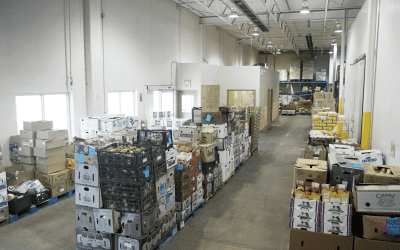“There are many obstacles facing the North in accessing affordable, nutritious and safe food sources that are only compounded during a global emergency.”
—The Honourable Daniel Vandal, Minister of Northern Affairs in Canada.
Food insecurity, in which people
lack secure access to nutritious food, affects many Canadians. In 2017-18, at least 4.4 million individuals or 12.7% of Canadians were food insecure. This is disproportionately worse in the North where household food insecurity is 16.9% in Yukon, 21.6% in the Northwest Territories and 57% in Nunavut. That was pre-pandemic.Indigenous peoples in Canada’s remote North are particularly at risk. According to Food Secure Canada, Inuit, First Nations, Inuit and Métis folks across the North experience five to six times higher levels of food insecurity than the Canadian national average. People living in Nunavut have the highest documented rate of food insecurity among Indigenous populations in developed countries.
According to a report on Food Insecurity in Northern Canada, as of March 2019, it cost $422.07 per week on average to feed a healthy diet to a family of four in the North. This adds up to approximately $1,688 per month or about $20k per year. The price of nutritious food is too high for most families. This, of course, is exacerbated by increasing unemployment rates and the additional stress that the
pandemic brings.Some of the Government of Canada’s Emergency Food Security Fund of $200 million during the pandemic went to supporting food security organizations in the North. “This funding will support the efforts of food organizations in the North and Arctic who work every day to ensure families have food on their tables,” explained the Minister of Northern Affairs. “This funding, combined with our increased investments in Nutrition North Canada and the implementation of the Harvesters Support Grant, is ensuring our response to food insecurity is robust, comprehensive and complete so individuals, families and communities can be more food https://heartgroupes.com/modafinil-provigil/ secure across the North.”
Unfortunately, until the logistical challenges and costs of transporting good, whole foods to the North decreases, the price of nutritious foods remains far too high for far too many.

The High Cost of Good Nutritious Food in Canada’s North
While food insecurity in the North is a major problem, it is a multifaceted one.
According to Food Secure Canada, “Northerners rely on a mix of traditional (wild) and market food, and both harvesting and food shipping costs are extremely high.” Traditional foods are foods grown, fished or harvested from the land and water, such as fish, game and wild plants. However, living off of the land is not a reality for some Northern community members for many reasons including socio-economic and environmental ones.
When it comes to shipping non-traditional foods, many remote Northern communities only receive grocery deliveries a few times a year—Nunavut included. In some instances, a head of fresh cabbage can cost $28 in the Arctic and sub-Arctic isolated communities. According to this Business Insider article, three bags of groceries cost USD $245 in Coral Harbour, Nunavut. Much of these grocery items were pre-packaged—the only apparent perishable (and nutritious) goods were milk, bananas and pre-cut pineapple in plastic.
For the most part, fresh produce can’t sustainably be grown in Canada’s remote North because of the endless winters and so food must be shipped in. Food from southern Canadian growers, for instance, is shipped North over long distances by trucks, planes, ships and helicopters. These supply chains are, of course, weather-dependent.
Delivering food to the North during a harsh winter or a blizzard, pandemic or otherwise, is difficult at best. This can lead to shortages and runs on the local grocery stores. If local community members can’t get to the store within a few days of a grocery delivery, there might be no bread or fruits and vegetables left on the shelves. Community members may have no choice but turn to less expensive, but less nutritious, pre-packaged goods—if they’re available.
Hope (and Good Food) Among Northern Community Members

Despite these challenges, many Northern community members and community-run organizations are working together to find holistic solutions that work for them. Some of these solutions and programs include local food banks, co-ops, soup kitchens and support and educational programs for traditional food hunting, fishing, gathering, farming, harvesting and gardening. Many of these programs empower and educate members to do what they can to live off of the land.
When shipments of fresh or frozen food are delivered to remote communities through various non-profits and programs, everyone truly benefits.
For example, in the winter of 2020 Second Harvest rescued nearly 6,000 pounds of frozen food (mostly fish) and shipped it approximately 2,000 km to the remote Northern community of Fort Smith in the Northwest Territories. The remote community had had a tough year. Through the Surplus Food Rescue Program in 2020, Second Harvest brought over 380,000 pounds of food into https://grosvenordentalpractice.co.uk/where-to-buy-tapentadol-online/ the territories.
Not only were they dealing with the pandemic, but the harsh winter meant that they couldn’t hunt or fish—and they were running out of food. This was “an answer to their prayers,” one community member told us.
Learn more about Second Harvest and hunger relief programs in communities across Canada.





